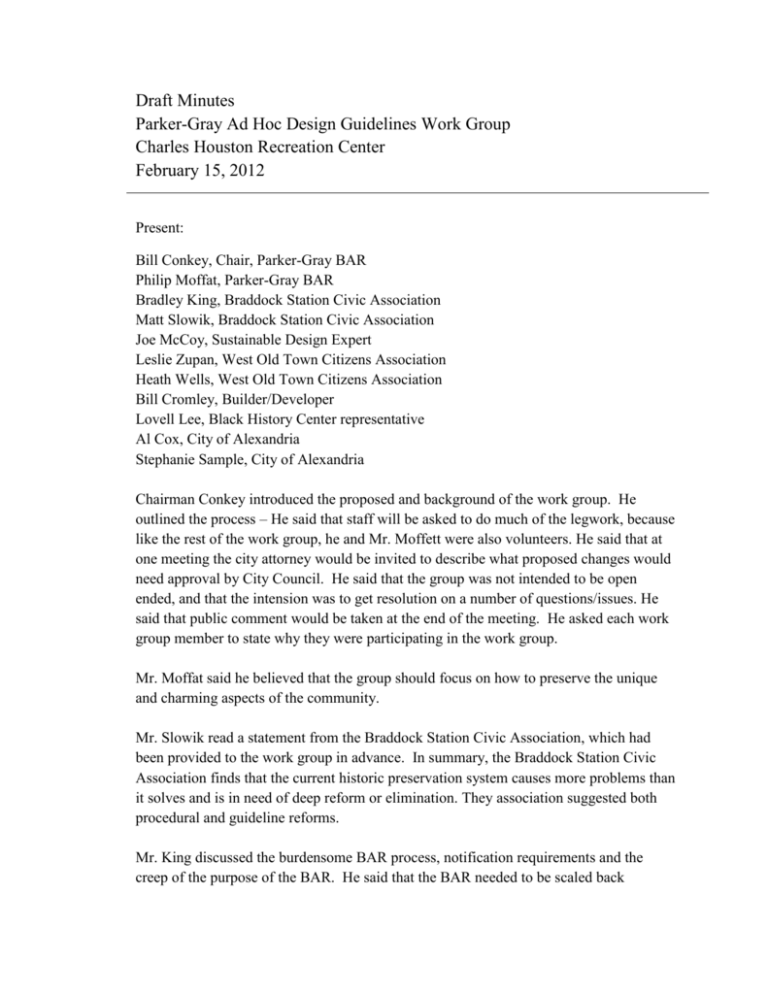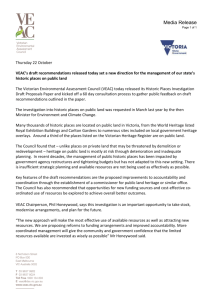here - WordPress.com
advertisement

Draft Minutes Parker-Gray Ad Hoc Design Guidelines Work Group Charles Houston Recreation Center February 15, 2012 Present: Bill Conkey, Chair, Parker-Gray BAR Philip Moffat, Parker-Gray BAR Bradley King, Braddock Station Civic Association Matt Slowik, Braddock Station Civic Association Joe McCoy, Sustainable Design Expert Leslie Zupan, West Old Town Citizens Association Heath Wells, West Old Town Citizens Association Bill Cromley, Builder/Developer Lovell Lee, Black History Center representative Al Cox, City of Alexandria Stephanie Sample, City of Alexandria Chairman Conkey introduced the proposed and background of the work group. He outlined the process – He said that staff will be asked to do much of the legwork, because like the rest of the work group, he and Mr. Moffett were also volunteers. He said that at one meeting the city attorney would be invited to describe what proposed changes would need approval by City Council. He said that the group was not intended to be open ended, and that the intension was to get resolution on a number of questions/issues. He said that public comment would be taken at the end of the meeting. He asked each work group member to state why they were participating in the work group. Mr. Moffat said he believed that the group should focus on how to preserve the unique and charming aspects of the community. Mr. Slowik read a statement from the Braddock Station Civic Association, which had been provided to the work group in advance. In summary, the Braddock Station Civic Association finds that the current historic preservation system causes more problems than it solves and is in need of deep reform or elimination. They association suggested both procedural and guideline reforms. Mr. King discussed the burdensome BAR process, notification requirements and the creep of the purpose of the BAR. He said that the BAR needed to be scaled back significantly. Mr. King suggested that staff could be advisory and have no enforcement authority. He also suggested that all members of the Parker-Gray BAR should be required to actually live in the historic district. Some members of the group asked that the modern materials information be forwarded to work group members before the next meeting. Mr. McCoy said that he was an architect and that historic preservation and green building aren’t opposing purposes. He talked about not picking a moment in timing and “freezing” buildings. He said that sustainability is embodied energy and that there are savings in preserving existing historic fabric. He said the complaints of preservation are: non-valuable things get protected; economic complaints – regulations make things more expensive. Ms. Zupan said that she had surveyed the members of her group, the West Old Town Citizens Association, and provided the results to the work group. She said in general that she’d like to see the group focus on customer service, consistency, modern materials, the eclectic nature of the district and what is being preserved. Mr. Wells said that a quarter of the people in the survey recommended abolishing the BAR, although he suspects even more people would like to abolish the BAR. HE said that the focus of the BAR isn’t where it should be. Mr. Wells mentioned a case where a woman received a stop work order for installing vinyl windows in Parker-Gray and was required to go to the BAR and install different windows. He said that she didn’t know she was in a historic district. He said that she was now selling her house. He also said that he was told he that he would have to retain his existing single pane windows and install interior storm windows, which would be expensive and not very efficient. He also said that he was not going to remove his aluminum siding on his house because he knew that he would not be permitted to replace the siding underneath with Hardie plank siding. Mr. Conkey said that there was clearly a need for better homeowner education to let people know that their houses are located in a historic district and what types of projects require review by the BAR and or BAR staff. He said that at the next meeting he would have staff start to educate the work group as to the process in place already. He also said that an element of predictability would also be very helpful for the community. Mr. Cromley stated that people have many different reasons for moving into a historic district and that he supports the use of modern materials in some instances but that abolishment of the district is not practical or a good idea. He said that he was in agreement with a lot that had been said, and that there was room for improvement. Parker-Gray has been a district since 1984 and suggested that there was a need for more education about the Design Guidelines, which offered more flexibility than people thought. He suggested that the group focus on areas of agreement, not disagreement. He asked that the next time the Work Group meets that Staff, Al Cox in particular, present the history and architectural development of the district. He said not only should he talk about the historic buildings in the district but also about the many modern buildings. He also suggested we look at other historic districts. Mr. Conkey confirmed that people who live in the district needed predictability. Mr. Lee related an instance where he tried to replace the slate roof on his property on North Alfred Street and he was not permitted to use fake slate, similar to what was used on the library on Queen Street. He said he agreed with Mr. King and his suggestion that all BAR members should be required to live in the district. Mr. Moffat said that he thought the group should be looking at how the group and the Board got to this juncture and where they were going, what changes were necessary. Mr. Slowik asked the group to look at Rosemont and Del Ray and make some comparisons. He wondered what was the worst that could happen to the mid-20th century buildings. Ms. Zupan also asked Staff to review the Town of Potomac, Rosemont and Fairlington and reminded people that there is a difference between locally regulated districts like Parker-Gray and National Register Districts, which aren’t regulated. Mr. Conkey said that there was definite value in having a historic district and that in some ways Parker-Gray was different from Old Town, in that it was more eclectic. He said that right now both the Old and Historic District and Parker-Gray District share the same Design Guidelines but maybe this work group can recommend a change to that practice. Perhaps the structures in Parker-Gray could be categorized somehow. Mr. Cromley said he would like to rank buildings but it may be difficult to enforce. Mr. Moffatt said that he wasn’t thinking of additional regulations but just guidelines, a more sophisticated system. Mr. King asked the group what they wanted rules for? New construction? Color palate? Or just to establish a few hard and fast rules? He said that homeowners could take some responsibility for self-regulating, as generally they are sensitive and conservative. Mr. Wells said that we should divide the meetings into: a mission meeting- what is our purview, what is required; exclusions meeting – broad categories, i.e. no porch lights, minor elements; and a process meeting. The group then listed a number of topics to be covered in the next meetings: Mission/purview Fees What is regulated or not Minor architectural elements – exclusions – porch lights Modern materials Process improvements Enforcement - neighborhood based Encroachment- fences Customer service Education/outreach Resources inventory & purpose of preservation Parker-Gray context Board membership Mr. Conkey then opened the meeting up for public comment. A gentleman named Matt who lives in a 1940s house on Suter Street said that he removed a steel canopy and that now he needed BAR review. He said that the BAR needed to be consistent and that there was a lot of variety in the neighborhood. He said that the history of the district was based on culture, not architecture. Mike, who lived on the 1000 block on Queen Street, said that staff was helpful but that he would like to be able to use modern and sustainable materials. He has to replace a slate roof and would like to use modern materials. Linda Lewis, who lives on Payne Street and has lived in the neighborhood her whole life, said that what is left in Parker-Gray is not historic. She said things have changed since the 1950s that no one cares about the history of Parker-Gray anymore. It’s a great neighborhood and a great place to live but it shouldn’t be frozen in time and it should be allowed to change. What point in time do you save? It’s a conflict between architecture and culture. She suggested keeping the charm but using modern materials to keep it looking good. She said that she didn’t think enforcement was necessary because Parker- Gray was not Old Town. It is the wood houses that suffer, not the brick houses. She said that the special areas within the district should be commemorated. A neighbor of one of the work group members commended the Parker Gray board for all of their hard work. A woman named Elizabeth purchased her property from an estate and said that she and her neighbors were not fans of the historic district. She said that the Board should look at the big picture and not focus on the small details. She said that because she and her husband had an immediate need for a roof repair, they opted not to go to the BAR and instead spent thousands of dollars more to install a more expensive roof material approved by BAR staff. Bradley, who lives on Suter Street, suggested a professional facilitator for the group. Sean, who lives on Payne Street, said that this is a democratic process and that the Board and staff work for the citizens. He said that there is a disconnect between the Board and Staff and the citizens. He said he wanted a ballot initiative and a more objective group. He asked what the Boards accountability was. Bradley King said that he fought for the Work Groups membership. Heath Wells said that he wants specific language developed by the work group to go to City Council. A woman who is a new owner of 804 Pendleton Street said that they just moved into the historic district because they like historic preservation and wanted to live in a historic district. She thought it was important for new owners in the district (like in James Bland) to know that they are located in a historic district and that certain limitations apply.






